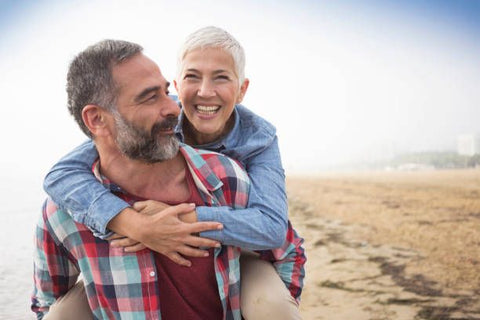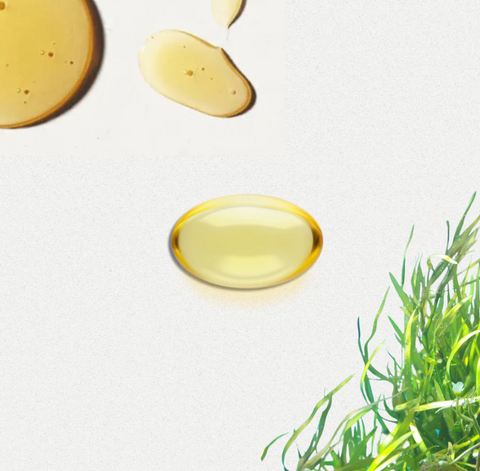Vaginal dryness associated with menopause is a consequence of the atrophy that this part of the body experiences at the end of fertile life and is usually accompanied by other symptoms.
These include vulvovaginitis (irritation, burning or itching of the vulva and/or vagina), decreased lubrication and pain during sexual intercourse , postcoital bleeding, decreased arousal, orgasm and desire, and increased urinary frequency.
This genital atrophy is progressive and the first symptoms may appear during perimenopause. Some women begin to experience discomfort such as vaginal dryness from the age of forty.
It is especially with the arrival of menopause that dryness and other symptoms of vaginal and vulvar atrophy intensify.
Cessation of ovarian function
The cessation of ovarian function leads to a decrease in the production of estrogen in the ovaries, and as a consequence, the vaginal wall becomes thinner and loses elasticity, the vaginal flora changes and the pH becomes alkaline, and the vaginal glands contract, reducing vaginal lubrication.
This sensation of vaginal dryness during menopause can also be increased by the consumption of medications for pathologies whose incidence increases with age or whose risk is increased at this stage of a woman's life, such as antidepressants, anticholinergics for the treatment of gastrointestinal disorders or certain antihypertensives.
At the same time, diabetes can also affect the lack of vaginal lubrication, especially if there is poor blood glucose control.
The cessation of estrogen production that occurs in all women means that vaginal dryness cannot be completely avoided during menopause.
However, there are different measures that can alleviate this symptom of genital atrophy and minimize its impact on a woman's quality of life.

How to improve vaginal dryness
LIFESTYLE.
Vulvar and vaginal pain and dryness can improve by changing certain habits, and a risk factor for female genital atrophy is smoking, because tobacco affects blood circulation and reduces the effects of natural estrogens in the body, so quitting smoking is a measure to relieve vaginal dryness during menopause.
A similar effect is associated with alcohol and marijuana consumption.

Obesity, associated with poor physical activity, is also related to a higher risk of genitourinary discomfort.
Another factor that can worsen vaginal dryness during menopause is stress. Increased cortisol levels in the blood produce an imbalance in the secretion of sexual hormones, including estrogen, which can affect vaginal hydration.
Another factor that would have a protective effect against vaginal dryness problems would be sexual activity , since activity through intercourse would promote elasticity, vascularization and vaginal lubrication.
INTIMATE HYGIENE.
A common cause of vaginal dryness at different stages of a woman's life is excessive genital hygiene or the use of overly harsh soaps. When intimate hygiene is inadequate, the vulvovaginal mucosa is irritated and the microbiota is altered, worsening the problems of atrophy and dryness. A soap specific to the pH of this area and limiting hygiene to the external genitals will prevent this problem.
Underwear made of nylon or other synthetic fibers, pants that are too tight, perfumed or plastic-coated pads, deodorant sprays, vaginal irrigators, and talcum powder for the genital area should be avoided.

MOISTURIZING AND LUBRICATING GELS. There are moisturizing creams and gels that act as lubricants and therefore combat vaginal dryness. This is possible by achieving a function similar to that of a woman's cervical mucus. They do not contain hormones and are lubricating creams without estrogens.
One of the most widely used and effective active ingredients as a lubricant for women in menopause is hyaluronic acid.
Hyaluronic acid also has a regenerative capacity, which facilitates cell migration during inflammation and the tissue repair process.
They should be used during sexual intercourse to reduce irritation caused by mucosal friction.

PHARMACOLOGICAL TREATMENTS .
Hormonal estrogen-based treatments have proven effective in improving vaginal dryness in menopause and other symptoms of genital atrophy , but unlike lubricant creams for menopause, these treatments are not free of side effects , especially in the case of systemic estrogens. Therefore, these drugs are only used in cases of moderate or severe vaginal dryness and atrophy.

COMPLEMENTARY TREATMENTS .
Treatment for vaginal dryness during menopause can be complemented with more recent techniques such as hyaluronic acid infiltration, laser or radiofrequency.
Submucosal injections into the outer third of the vagina have been shown to provide hydration, stimulate the extracellular matrix, and tone tissues.
In turn, the infiltration of hyaluronic acid at the level of the vulvar lips seems to achieve greater labial volume and a reduction in the sensation of friction during intercourse.
As for the laser, it stands out for being a non-invasive technique, with few side effects and rapid results.
Available evidence indicates that both technologies successfully improve genital atrophy and vaginal hyperlaxity, with or without urinary incontinence. As a result, they alleviate discomfort caused by vaginal dryness, as well as pain during sexual intercourse.
Finally, radiofrequency appears to improve vulvovaginal laxity by producing changes in the structure of collagen and elastin . However, the evidence available for this technique is still scarce.

PHYTOTHERAPY AND FOOD.
Regarding phytotherapy for the treatment of vaginal dryness in menopause (for example, borage and evening primrose oil, don quai or green tea, among many others), there are not enough studies to support its recommendation.
As for soy isoflavones, the evidence is controversial, while home remedies for vaginal dryness such as using Vaseline or coconut oil should be avoided.
It is important to note that you should see a gynecologist if this symptom or other discomfort associated with genital atrophy appears . This way, a proper diagnosis can be made and the most suitable treatment prescribed in each case.
Omega 7 or palmitoleic acid (C16:1 n-7) is a non-essential monounsaturated fatty acid that is formed in the body from the conversion of glucose into fatty acids.
Palmitoleic acid (PA) is present in nature in the oil of the sea buckthorn bush with the botanical name Hippophae rhamnoides, a natural and beneficial product that can help us with different conditions caused by diseases of the skin and mucous membranes by improving their regeneration and nutrition.

Helps strengthen and renew cell membranes at the level of mucous membranes and skin.
Helps nourish and hydrate dry, sensitive and aging skin.
-
Helps maintain healthy skin.
Helps nourish and maintain healthy mucous membranes.
Studies have been conducted on it as an adjuvant not only in skin and urogenital conditions but also in ulcers and digestive inflammations.
We also find PA in macadamia nut oil (Macadamia integrifolia) as well as in sea buckthorn oil (Hippophae rhamnoides) with high concentrations of around 17% and 40%, respectively. Other sources of omega 7 are avocado, olive oil and in the animal kingdom in certain cheeses such as cheddar and butter, although they contain very little PA.
Sea buckthorn oil is also rich in linolenic (omega 3), linoleic (omega 6) and oleic (omega 9) acids, and in natural antioxidants (tocopherols and tocotrienols).
https://www.institutodelamenopausia.com/divulgacion/tratamientos/medicina-natural/la-lubricacion-en-la-menopausia
https://www.nia.nih.gov/espanol/menopause/sexo-menopause-treatment-symptoms
Nieto, L. Iglesias, EM Cuerva, MJ Basic manual of menopause [online]. Group of Young Experts of the Spanish Association for the Study of Menopause, 2020. < https://aeem.es/wp-content/uploads /2020/05/n1870_libro-jovenes-aeem-04-05-20-baja12.pdf>
Editorial. SEGO recommendations for women on the prevention and treatment of vaginal atrophy [online]. Spanish Society of Gynecology and Obstetrics. <https://sego.es/mujeres/Problemas_ginecologicos.pdf>
Palacios, S. Cancelo, MJ et alt. Recommendations of the Spanish Society of Gynecology and Obstetrics on the prevention and treatment of vaginal atrophy [online]. Progress in Obstetrics and Gynecology, 2012. <https://www.elsevier.org/ .es/es-journal-progress-obstetrics-gynecology-151-article-recommendations-spanish-society-gynecology-obstetrics-S0304501312001513>





Comments (0)
There are no comments for this article. Be the first one to leave a message!